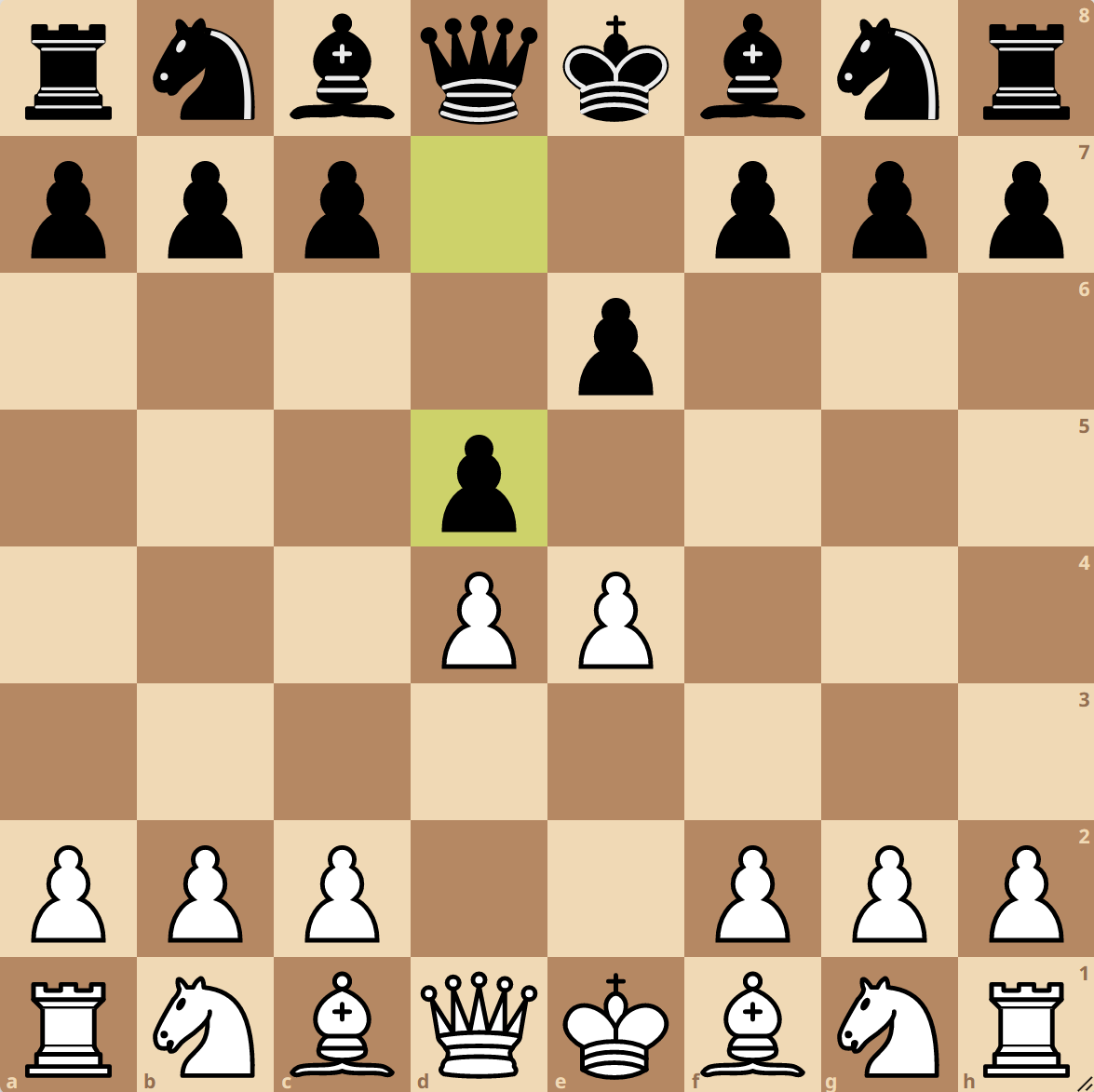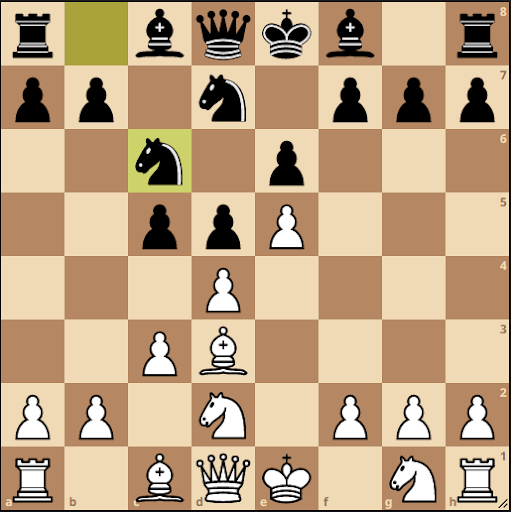Learn Chess. Learn Life Lessons.
Come, join us and transform your kid’s life through chess.
Join Online Coaching Join In-Person Coaching
The French Defense is a King Pawn Opening where Black responds to White’s e4 with e6 with the intention of advancing the d pawn to d5. The opening is strong, aggressive, dependable, and solid and is played by some renowned Grand Masters.
When White plays 1.e4, the classic (and simple) response is 1…e5. Yet this open-game response doesn’t always result in much fun for Black. A great alternative is 1…e6 to set up the French Defense. The French Defense is Black’s counter-attack to a King’s pawn opening from White, beginning with 1.e4 e6, and thus a semi-open game. The main line continues with 2.d4 d5. This opening is a dependable, often aggressive play that offers much success for determined, ambitious players.
This article will provide a basic overview of the French Defense, including how and why to play it and the principles and theory behind it.

The idea behind the French Defense is that Black plays e6 to prepare to advance the d5 pawn, in order to immediately challenge White’s pawn on e4. It is a solid and sharp opening, and it has been played by some of the greatest chess players in the world.
Following the opening moves 1.e4 e6, the main line of the French Defense continues 2.d4 d5. White sets up a pawn center, which Black immediately challenges by attacking the pawn on e4, which was the main idea as mentioned above. White’s options include defending the e4-pawn with either 3.Nc3 or 3.Nd2. Further White can even advance the pawn with 3.e5, or exchange the pawn with 3.exd5, each of which leads to different types of positions.
The principle behind the French Defense is mostly counter-attack. It’s considered a treacherous play at times, seeing as how Black does surrender space.
This is a bold move for those seeking a win playing the Black pieces, and it tends to begin an intense and unyielding battle wherein there are various possible outcomes.
The theory in using the French Defense is that Black delays the battle for the center by playing 1…e6, simultaneously preparing for a d7-d5 advance so as to promptly challenge White’s e4 pawn.
This avoids any symmetry from the beginning and allows White to take space with the e5 advance.
Black continues under the assertion he can subvert White’s advanced center later, having set up a firm and secure center with the e6-d5 pawn chain.
One of the main concepts to recognize with this opening is that while White tends to fixate on the King’s side, Black commonly counter-attacks on the Queen’s side. This often creates competition over who will get the first strike.
Additionally, Black’s Queenside Bishop is blocked immediately with 1.e6. This challenge is an intrinsic theme of the French Defense, advantageous for White, that entire games often center around.
The four major variations are:

Most games beginning with 1.e4 e6 will progress with White and Black advancing their Queen’s pawns with 2.d4 d5, setting up the main tabiya for the French Defense. Black’s thrust into the center with 2…d5 establishes a semi-open game and leaves White with the dilemma of how to defend the e4 pawn.
White’s most logical and imperative move is to continue along the Main Line and play 3.Nc3. With this move, White defends the e4 pawn by developing the Knight to c3, its most active square. The decision to play e5 can still be made later in the game, should the move become beneficial. By leaving Black’s d5 pawn under pressure, White creates a troublesome consequence should Black decide to play the quick 3…c5. Nc3 is the main move for White for a reason – it is a logical move, developing a piece and protecting the pawn on e4.

This variation creates a symmetrical pawn structure, making it great for those who favor strategic battles and beginning players who still lack significant knowledge of opening theory. Though it has a drawish reputation, the exchange can be quite exciting, as it allows numerous possible plays for both Black and White at every move.
The innocuous 3.exd5 exd5 allows Black to maintain a space in the center with a pawn, and optimal placement easily follows with these initial issues equalized.
This is a sturdy yet bold play wherein White’s advance to e5 claims a space advantage and secures the position while denying Black’s Knight the f6 square. White wants to gain space in the center and fix Black’s pawn structures on the light squares, which will lock in Black’s Bishop on c8. A long-term plan is to push ‘f’ pawn to f5 in order to break apart Black’s solid central pawn structure and eventually start a Kingside attack.
Although, White’s direct aim at a Kingside space advantage is burdened with playing defense when Black strikes at d4, resulting in a time loss. Notably, this variation strains the c8 Bishop’s ability to join the game – a fundamental impediment in the French Defense – as White is obstructing Black’s light-square pawns.
The fully secured center requires a unique approach that many players are unfamiliar with, as it differs from those used in open-center games. The strategy is to attack the pawn chain at its base with the counterstrike move 3…c5.
From here, Black can go a couple of ways, though the typical reply is 5…Qb6. With this move, Black puts d4 under heavy pressure to eventually weaken White’s center. The b2 square is also hit by the Queen, meaning the b3-pawn must be forfeited to make it easier for White’s dark-squared Bishop to protect the d4-pawn.

The Tarrasch Variation is a popular choice, perfect for those who don’t care for aggressive lines or completely symmetrical positions. It’s less aggressive than the Main Line 3.Nc3; still, it provides White the opportunity to obtain a slight advantage with conservative play.
In utilizing this flexible and sophisticated option, White bypasses making a choice in the center and evades the …Bb4 pin of the Winawer Variation by taking on a somewhat passive development of his Knight in exchange for leaving the c-pawn unobstructed; Allowing this pawn to reach c3 could strengthen White’s center later. However, this typically costs White an extra tempo moving the Knight before his dark-squared Bishop can be developed.

In order to activate the bishop on c1, White will often plays Ndf3 and Ne2 after playing Bd3, so the second Bishop isn’t blocked by a knight. Another strategy for White is to exchange Black’s strong bishop on d6 with Bg5 followed by h4 and g3.
While the French Defense is a strong, strategic opening, Black is quite passive and may occasionally struggle to maneuver. Knowing traps in this defense can assist with a quick win should your opponent take a misstep in the opening.
Here’s a trap game in Black’s favor:

And here’s a trap game in White’s favor:

The most glaring weakness of the French Defense for Black is that the queen-side Bishop is immediately blocked by the beginning move 1.e6. Most often, the whole game centers around this weakness. Still, there are ways for Black to mobilize his c8 Bishop despite the limitation later in the game.
Here are some win-rates based on White’s initial response to the French Defense:
| Move Played | Games | White Win (%) | Draw (%) | Black Win (%) |
|---|---|---|---|---|
| 3. Nc3 | 23,118 | 41.4% | 32.2% | 26.4% |
| 3. Nd2 | 14,821 | 39.5% | 37% | 23.4% |
| 3. e5 | 4,862 | 38.9% | 26% | 35.1% |
| 3. exd5 | 3,199 | 27.6% | 39.6% | 32.8% |
| 3. Bd3 | 388 | 46.9% | 23.7% | 29.4% |
| 3. c4 | 54 | 38.9% | 20.4% | 40.7% |
| 3. Be3 | 48 | 41.7% | 22.9% | 35.4% |
| 3. Nf3 | 5 | 40% | - | 60% |
| 3. f3 | 5 | 20% | - | 80% |
The French Defense has been favored by many players, both past and present, with several GMs routinely using it as one of their main opening armaments.
Some popular players of the French Defense include:
Many great French Defence games have been influential to many players, such as the 1976 Reshevsky vs. Vaganian game, which you can walk through in detail with this video:
Tactics in the Chess Opening 3: French Defence and Other Half-Open Games
Part of a six-book series, this title covers the basics of the French Defense using a collection of both new and classic games that have been annotated with descriptive and analytic commentary by its authors. It’s best suited for beginners still learning the theory behind the French Defense and other openings.
French Defense: 1.e4 e6 in Chess Openings
In this book, Tim Sawyer explains the French Defense strategy, analyzing over 120 games and touching on all the common variations. This version includes up-to-date commentary by the author that shares details about game settings and opponents, often appreciated by those just beginning to understand the theory.
The Complete French Advance: The Most Uncompromising Way to Attack the French Defense
Written by GM Evgeny Sveshnikov, a highly respected expert in chess openings, and Vladimir Sveshnikov, an International Master, this title covers a ruthless path to victory against the French Defence. It provides an excellent monograph of the French Defense, guaranteed to help raise your gameplay to the next level.
What To Do After French Defense?
What’s best for White to do after the French Defense is set with 2…d5 is to move e4-e5. This gives White a space advantage and closes the center. Also, Black’s d5 and e6 pawns obstruct his c8 Bishop, which will struggle to mobilize. However, Black will have a solid pawn structure.
Is the French Defense Good for Beginners?
The French Defense is good for beginners to learn, as it provides understanding into pawn chains, space advantage, navigating from closed positions, outposts, good/bad pieces, and more. It doesn’t require you to know tons of theory to play, and it can help you become a more versatile player.
Why Is It Called the French Defense?
The French Defense is called so in recognition of the Paris Chess Club, who, in a correspondence game with London in 1834, carried out this opening and earned a conclusive win. Although, this French team did not originate the maneuver, as it had been established in the 15th century.
What Is the Best Variation for the French Defense?
Many consider the best variation for the French Defense for Black to be the Winawer, and safe alternatives being the Burn and Classical Variations. Advanced players also like the Tarrasch. White’s best gambits against the French include the Alekhine-Chatard Attack and the unofficial Korchnoi Gambit.
The French Defense is a great counter-attack opening for Black that often leads to sharp, strategic games and a play that all chess players should have in their repertoire.
To learn more, and attempt to unlock its full potential, check out this excerpt from the 17-hour mastery class “The Bulletproof French Defense” by French GM Fabien Libiszewski:
Learn Chess. Learn Life Lessons.
Help your child improve their Strategic Thinking, Critical Thinking, Time Management, etc. through the game of Chess.

This article is technically edited and reviewed by Grand Master Marian Petrov.

CHESS KLUB offers chess classes for kids and adults of all levels. Our coaches include FIDE, National, International and Grand Masters among many.
We offer Online and Classroom coaching.
CHESS KLUB has coaching centers in the US and India now!
Do you want to see your kid excel in Chess?
Learn Chess. Learn Life Lessons.
